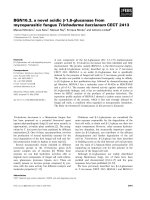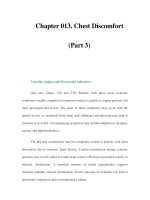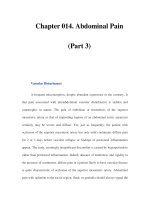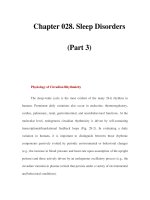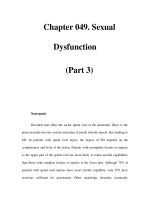Chapter 3 (numerical measures part b) student
Bạn đang xem bản rút gọn của tài liệu. Xem và tải ngay bản đầy đủ của tài liệu tại đây (168.03 KB, 29 trang )
Chapter 3
Statistical
measures
Measure center and
location
Measure
variation/dispersion
Summary
Statistical
measures
Center and
location
- Mean
(arithmetic,
weighted,
geometric)
- Mode, Median
Variation/Disper
sion
- Range
- Variance
- Standard
deviation
1.
2.
3.
4.
5.
Part B
Measures of
variation/dispersion
Range
Mean deviation
Variance
Standard deviation
Coefficient of variation
1. The range
The range is defined as the numerical
difference between the smallest and
largest values of the items in a set or
distribution
Formula:
R = largest value – smallest
value
Example
Ages of two groups of people on survey:
Group
A
20
30
40
50
60
Group
B
38
39
40
41
42
Advantages and
disadvantages
of the range
Advantages:
Disadvantages:
Implication
2. The mean deviation
The mean deviation is a measure of
dispersion that gives the average
difference (i.e. ignoring ‘-’ signs) between
each item and mean.
Formula:
- For a data set
n
d =
∑x
i =1
i
n
−x
Formulae
- For a frequency distribution
k
d =
∑f
i =1
i
xi − x
k
∑f
i =1
i
Example
Group
A
Group
B
20
30
40
50
60
38
39
40
41
42
n
dA =
∑
i =1
xi − x
n
Example
Group
A
Group
B
20
30
40
50
60
38
39
40
41
42
n
dB =
∑
i =1
xi − x
n
Example
The data in
table below
relates to the
productivity
(kg/person) of
100 workers in
a small factory
Mean
deviation?
Productivi
ty
(kg/perso
n)
<10
10 – 20
20 – 30
30 – 35
35 – 40
≥ 40
Number
of
workers
7
18
25
20
18
12
Characteristics of the mean
deviation
A better measure of dispersion than the
range
Useful for comparing the variability
between distributions
Can be complicated to calculate in
practice if the mean is anything other than
a whole number.
3. Variance
Variance is another statistical measure of
dispersion
It is defined as the average of squared
discrepancies between each data value
and their mean
Formula:
For a set of values
n
σ =
2
∑ (x
i =1
i
− x)
2
n
n
or
σ2 =
2
x
∑i
i =1
n
− ( x )2 = x 2 − ( x )2
The mean of the squares less the square
of the mean
For a frequency
distribution
k
2
(
x
−
x
)
fi
∑
i
2
i =1
σ =
k
∑f
i =1
i
k
or
σ2 =
2
x
∑ i fi
i =1
k
∑f
i =1
− ( x )2 = x 2 − ( x )2
i
The mean of the squares less the square
of the mean
Example
Group
A
Group
B
20
30
40
50
60
38
39
40
41
42
n
σ2 =
2
(
x
−
x
)
∑ i
i =1
n
Example
The data in
table below
relates to the
productivity
(kg/person) of
100 workers in
a small factory
Variance?
Productivi
ty
(kg/perso
n)
>10
10 – 20
20 – 30
30 – 35
35 – 40
≥ 40
Number
of
workers
7
18
25
20
18
12
Characteristics of the
variance
A better measure of dispersion than the
range
Complicated since it multiply the
discrepancies
The unit of the variance is not meaningful
4. Standard deviation
Standard deviation is defined as the
square root of the variance.
Formula
For a set of values
n
∑( x
σ =
n
or
σ=
i =1
n
− x)
n
∑x
i =1
i
2
2
i
− (x ) = x − (x )
2
2
2
For a frequency
distribution
k
∑( x
σ =
i =1
i
− x)
2
fi
k
∑f
i =1
i
k
or
σ =
2
x
∑ i fi
i =1
k
∑f
i =1
i
− ( x )2 =
x2 − ( x )2
Example
Group
A
Group
B
20
30
40
50
60
38
39
40
41
42
σ= σ
2
Example
The data in
table below
relates to the
productivity
(kg/person) of
100 workers in
a small factory
Standard
deviation?
Productivi
ty
(kg/perso
n)
>10
10 – 20
20 – 30
30 – 35
35 – 40
≥ 40
Number
of
workers
7
18
25
20
18
12
Characteristics of Standard
Deviation
Can be regarded as one of the most useful
and appropriate measure of dispersion.
For distribution that are not too skewed:
- 99.7% of the data items should lie within
three standard deviation of the mean
- 95% of the data items should lie within
two standard deviation
- 68% of the data items should lie within
one standard deviation of the mean

